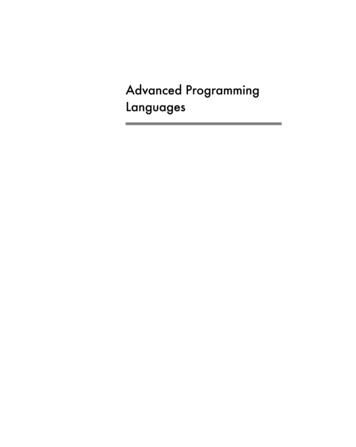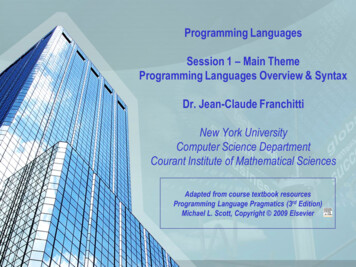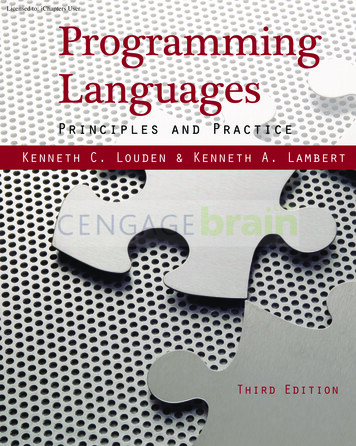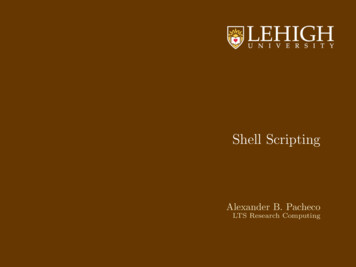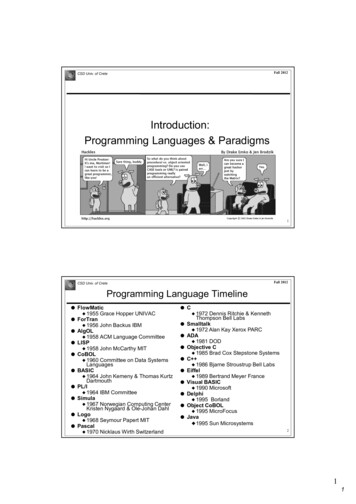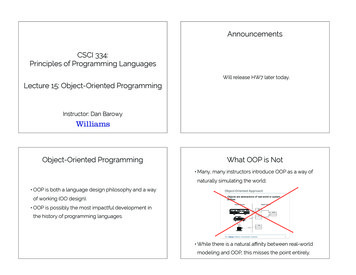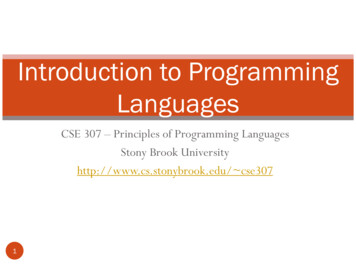
Transcription
Introduction to ProgrammingLanguagesCSE 307 – Principles of Programming LanguagesStony Brook Universityhttp://www.cs.stonybrook.edu/ cse3071
Introduction At the beginning there was only machinelanguage: a sequence of bits that directlycontrols a processor, causing it to add,compare, move data from one place toanother Example: GCD program in x86 machinelanguage:2(c) Paul Fodor (CS Stony Brook) and Elsevier
Introduction Assembly languages wereinvented to allow themachine operations to beexpressed with mnemonicabbreviations Example: GCD program inx86 assembler:3(c) Paul Fodor (CS Stony Brook) and Elsevier
Introduction Assemblers were eventually augmented with elaborate“macro expansion” facilities to permit programmers todefine parameterized abbreviations for commonsequences of instructions Problem: each different kind of computer had to beprogrammed in its own assembly language People began to wish for a machine-independent languages These wishes led in the mid-1950s to the development ofstandard higher-level languages compiled for differentarchitectures by compilers4(c) Paul Fodor (CS Stony Brook) and Elsevier
Introduction Today there are thousands of high-levelprogramming languages, and new onescontinue to emerge Why are there so many? Evolution Special Purposes Personal Preference5(c) Paul Fodor (CS Stony Brook) and Elsevier
Introduction What makes a language successful? easy to learn (python, BASIC, Pascal, LOGO, Scheme) easy to express things, easy use once fluent, "powerful” (C,6Java, Common Lisp, APL, Algol-68, Perl) easy to implement (Javascript, BASIC, Forth) possible to compile to very good (fast/small) code (Fortran,C) backing of a powerful sponsor (Java, Visual Basic, COBOL,PL/1, Ada) wide dissemination at minimal cost (Java, Pascal, Turing,erlang)(c) Paul Fodor (CS Stony Brook) and Elsevier
Introduction Why do we have programming languages? What is alanguage for? way of thinking -- way of expressing algorithms languages from the user's point of view abstraction of virtual machine -- way of specifyingwhat you want the hardware to do without getting down into thebits languages from the implementor's point of view7(c) Paul Fodor (CS Stony Brook) and Elsevier
Why study programming languages? Help you choose a language: C vs. C for systems programming Matlab vs. Python vs. R for numerical computations Android vs. Java vs. ObjectiveC vs. Javascript forembedded systems Python vs. Ruby vs. Common Lisp vs. Scheme vs.ML for symbolic data manipulation Java RPC (JAX-RPC) vs. C/CORBA for networkedPC programs8(c) Paul Fodor (CS Stony Brook) and Elsevier
Why study programming languages? Make it easier to learn new languages some languages are similar: easy to walk down familytree concepts have even more similarity; if you think interms of iteration, recursion, abstraction (forexample), you will find it easier to assimilate thesyntax and semantic details of a new language than ifyou try to pick it up in a vacuum. Think of an analogy to human languages: good grasp of9grammar makes it easier to pick up new languages (at leastIndo-European)(c) Paul Fodor (CS Stony Brook) and Elsevier
Why study programming languages? Help you make better use of whatever language you use understand obscure features: In C, help you understand unions, arrays & pointers,separate compilation, catch and throw In Common Lisp, help you understand first-classfunctions/closures, streams, catch and throw,symbol internals10(c) Paul Fodor (CS Stony Brook) and Elsevier
Why study programming languages? Help you make better use of whatever language you use understand implementation costs: choose betweenalternative ways of doing things, based on knowledgeof what will be done underneath: use simple arithmetic ops. (use x*x instead of x**2) avoid call by value with large data items in Pascal avoid the use of call by name in Algol 60 choose between computation and table lookup (e.g. forFibonacci function) use C pointers or Pascal "with" statement to factoraddress calculations11(c) Paul Fodor (CS Stony Brook) and Elsevier
Why study programming languages? Help you make better use of whatever language you use figure out how to do things in languages that don'tsupport them explicitly: lack of recursion in Fortran, CSP, etc. write a recursive algorithm then use mechanical recursionelimination (even for things that aren't quite tail recursive) lack of suitable control structures in Fortran use comments and programmer discipline for controlstructureso lack of named constants and enumerations in Fortran use variables that are initialized once, then never changed lack of modules in C and Pascal use comments and12programmer discipline(c) Paul Fodor (CS Stony Brook) and Elsevier
Classifications Many classifications group languages as: imperative von Neumann object-oriented scripting languages declarative functional logic, constraint-based(Fortran, Pascal, Basic, C)(Smalltalk, Eiffel, C ?)(Perl, Python, JavaScript, PHP)(Scheme, ML, pure Lisp, FP)(Prolog, VisiCalc, RPG) Many more classifications: markup languages,13assembly languages, query languages for DBs,controlled natural languages, etc.(c) Paul Fodor (CS Stony Brook) and Elsevier
HW1 (part of hw1) Write and test the GCD Program in different languages, like C, Prolog, SMLand Python: In C:14int main() {int i getint(), j getint();while (i ! j) {Due: on Blackboard.if (i j) i i - j;else j j - i;}putint(i);} In Python: In XSB Prolog:def gcd(a, b):gcd(A,B,G) :- A B, G A.if a b:return agcd(A,B,G) :- A B, C is A-B, gcd(C,B,G).gcd(A,B,G) :- A B, C is B-A, gcd(C,A,G). else:if a b: In SML:return gcd(a-b, b)else:fun gcd(m,n):int if m n then nreturn gcd(a, b-a) else if m n then gcd(m-n,n) else gcd(m,n-m); (c) Paul Fodor (CS Stony Brook) and Elsevier
Imperative languages Imperative languages, particularly the vonNeumann languages, predominate in industry data is modified in memory both control flow and data flow interleaved harder to analyze and optimize than otherparadigms (like functional and logic programming)15(c) Paul Fodor (CS Stony Brook) and Elsevier
Compilation vs. Interpretation Compilation vs. interpretation not opposites not a clear-cut distinction Pure Compilation: The compiler translates the high-level sourceprogram into an equivalent target program(typically in machine language), and then goes away:16(c) Paul Fodor (CS Stony Brook) and Elsevier
Compilation vs. Interpretation Pure Interpretation: Interpreter stays around for the execution ofthe program Interpreter is the locus of control duringexecution17(c) Paul Fodor (CS Stony Brook) and Elsevier
Compilation vs. Interpretation Interpretation: Greater flexibility Better diagnostics (error messages) Compilation Better performance!18(c) Paul Fodor (CS Stony Brook) and Elsevier
Compilation vs. Interpretation Common case is compilation or simple pre-processing, followed by interpretation Most modern language implementationsinclude a mixture of both compilation andinterpretation (Java, C#, ObjectiveC, Dart)19(c) Paul Fodor (CS Stony Brook) and Elsevier
Compilation vs. Interpretation Note that compilation does NOT have toproduce machine language for some sort ofhardware Compilation is translation from one language intoanother, with full analysis of the meaning of the input Compilation entails semantic understanding ofwhat is being processed; pre-processing does not A pre-processor will often let errors through.20(c) Paul Fodor (CS Stony Brook) and Elsevier
Compilation vs. Interpretation Many compiled languages have interpretedpieces, e.g., formats in Fortran or C Most compiled languages use “virtualinstructions” set operations in Pascal string manipulation in Basic Some compilers produce nothing but virtualinstructions, e.g., Java bytecode, Pascal P-code,Microsoft COM (.net)21(c) Paul Fodor (CS Stony Brook) and Elsevier
Compilation vs. Interpretation Implementation strategies: Preprocessor Removes comments and white space Groups characters into tokens (keywords,identifiers, numbers, symbols) Expands abbreviations in the style of a macroassembler Identifies higher-level syntactic structures(loops, subroutines)22(c) Paul Fodor (CS Stony Brook) and Elsevier
Compilation vs. Interpretation Implementation strategies: The C Preprocessor: removes comments expands macros23(c) Paul Fodor (CS Stony Brook) and Elsevier
Compilation vs. Interpretation Implementation strategies: Library of Routines and Linking Compiler uses a linker program to merge theappropriate library of subroutines (e.g., mathfunctions such as sin, cos, log, etc.) into the finalprogram:24(c) Paul Fodor (CS Stony Brook) and Elsevier
Compilation vs. Interpretation Implementation strategies: Post-compilation Assembly Facilitates debugging (assembly language easier for people to read) Isolates the compiler from changes in the format of machinelanguage files (only assembler must be changed, is shared by manycompilers)25(c) Paul Fodor (CS Stony Brook) and Elsevier
Compilation vs. Interpretation Implementation strategies: Source-to-Source Translation C implementations based onthe early AT&T compilergenerated an intermediateprogram in C, instead of anassembly language26(c) Paul Fodor (CS Stony Brook) and Elsevier
Compilation vs. Interpretation Implementation strategies: Bootstrapping: many compilers are self-hosting: they arewritten in the language they compile How does one compile the compiler in the first place? Response: one starts with a simple implementation—often aninterpreter—and uses it to build progressively more sophisticatedversions27(c) Paul Fodor (CS Stony Brook) and Elsevier
Compilation vs. Interpretation Implementation strategies: Compilation of Interpreted Languages (e.g.,Prolog, Lisp, Smalltalk, Java 9 jlink, C#): The compiler generates code that makes28assumptions about decisions that won’t be finalizeduntil runtime. If these assumptions are valid, the code runs veryfast. If not, a dynamic check will revert to theinterpreter. Permit a lot of late binding(c) Paul Fodor (CS Stony Brook) and Elsevier
Compilation vs. Interpretation Implementation strategies: Dynamic and Just-in-Time Compilation In some cases a programming system may deliberately delay compilation untilthe last possible moment Lisp or Prolog invoke the compiler on the fly, to translate newly created sourceinto machine language, or to optimize the code for a particular inputset (e.g., dynamic indexing in Prolog). The Java language definition defines a machine-independent intermediate formknown as byte code. Bytecode is the standard format for distribution of Javaprograms:o it allows programs to be transferred easily over the Internet, and then runon any platform The main C# compiler produces .NET Common Intermediate Language(CIL), which is then translated into machine code immediately prior toexecution.29(c) Paul Fodor (CS Stony Brook) and Elsevier
Compilation vs. Interpretation Implementation strategies: Microcode: Assembly-level instruction set is notimplemented in hardware; it runs on aninterpreter. The interpreter is written in low-levelinstructions (microcode or firmware),which are stored in read-only memory andexecuted by the hardware.30(c) Paul Fodor (CS Stony Brook) and Elsevier
Compilation vs. Interpretation Compilers exist for some interpreted languages, but they aren'tpure: selective compilation of compilable pieces and extra-sophisticated pre-processing of remaining source Interpretation is still necessary E.g., XSB Prolog is compiled into .wam (Warren Abstract Machine) files and thenexecuted by the interpreter31 Unconventional compilers: text formatters: TEX and troff are actually compilers silicon compilers: laser printers themselves incorporate interpreters forthe Postscript page description language query language processors for database systems are also compilers:translate languages like SQL into primitive operations (e.g., tuplerelational calculus and domain relational calculus)(c) Paul Fodor (CS Stony Brook) and Elsevier
Programming Environment Tools Tools/IDEs: Compilers and interpreters do not exist in isolation Programmers are assisted by tools and IDEs32(c) Paul Fodor (CS Stony Brook) and Elsevier
An Overview of Compilation Phases of Compilation33(c) Paul Fodor (CS Stony Brook) and Elsevier
An Overview of Compilation Scanning: divides the program into "tokens", which are thesmallest meaningful units; this saves time, sincecharacter-by-character processing is slow we can tune the scanner better if its job is simple; italso saves complexity (lots of it) for later stages you can design a parser to take characters instead oftokens as input, but it isn't pretty Scanning is recognition of a regular language, e.g., viaDFA (Deterministic finite automaton)34(c) Paul Fodor (CS Stony Brook) and Elsevier
An Overview of Compilation Parsing is recognition of a context-freelanguage, e.g., via PDA (Pushdownautomaton) Parsing discovers the "context free"structure of the program Informally, it finds the structure you candescribe with syntax diagrams (e.g., the"circles and arrows" in a language manual)35(c) Paul Fodor (CS Stony Brook) and Elsevier
An Overview of Compilation Semantic analysis is the discovery of meaningin the program The compiler actually does what is calledSTATIC semantic analysis that's the meaningthat can be figured out at compile time Some things (e.g., array subscript out ofbounds) can't be figured out until run time.Things like that are part of the program'sDYNAMIC semantics.36(c) Paul Fodor (CS Stony Brook) and Elsevier
An Overview of Compilation Intermediate Form (IF) is done after semantic37analysis (if the program passes all checks) IFs are often chosen for machine independence, easeof optimization, or compactness (these aresomewhat contradictory) They often resemble machine code for someimaginary idealized machine; e.g. a stackmachine, or a machine with arbitrarily manyregisters Many compilers actually move the code throughmore than one IF(c) Paul Fodor (CS Stony Brook) and Elsevier
An Overview of Compilation Optimization takes an intermediate-codeprogram and produces another one thatdoes the same thing faster, or in less space The term is a misnomer; we just improvecode The optimization phase is optional38(c) Paul Fodor (CS Stony Brook) and Elsevier
An Overview of Compilation Code generation phase produces assemblylanguage or (sometime) relocatablemachine language Certain machine-specific optimizations (useof special instructions or addressing modes,etc.) may be performed during or aftertarget code generation39(c) Paul Fodor (CS Stony Brook) and Elsevier
An Overview of Compilation Symbol table: all phases rely on a symboltable that keeps track of all the identifiersin the program and what the compilerknows about them This symbol table may be retained (in someform) for use by a debugger, even aftercompilation has completed40(c) Paul Fodor (CS Stony Brook) and Elsevier
An Overview of Compilation Example, take the GCD Program (in C):int main() {int i getint(), j getint();while (i ! j) {if (i j) i i - j;else j j - i;}putint(i);}41(c) Paul Fodor (CS Stony Brook) and Elsevier
An Overview of Compilation Lexical and Syntax Analysis GCD Program Tokens Scanning (lexical analysis) and parsing recognize the structure of theprogram, groups characters into tokens, the smallest meaningful unitsof the programintintwhileifelse}putint}42maini((j( ii )getint! j{(jj-(i);)))i,j{i;(c) Paul Fodor (CS Stony Brook) and Elsevier getinti-()j;;
An Overview of Compilation Lexical and Syntax Analysis Context-Free Grammar and Parsing Parsing organizes tokens into a parse tree thatrepresents higher-level constructs in terms of theirconstituents Potentially recursive rules known as context-freegrammar define the ways in which theseconstituents combine43(c) Paul Fodor (CS Stony Brook) and Elsevier
An Overview of Compilation Context-Free Grammar and Parsing Grammar Example for while loops in C:44while-iteration-statement while ( expression ) statementstatement, in turn, is often a list enclosed in braces:statement compound-statementcompound-statement { block-item-list opt }whereblock-item-list opt block-item-listorblock-item-list opt ϵandblock-item-list block-itemblock-item-list block-item-list block-itemblock-item declarationblock-item statement(c) Paul Fodor (CS Stony Brook) and Elsevier
An Overview of Compilation Context-Free Grammar and Parsing GCD Program Parse Tree:BA45next slide(c) Paul Fodor (CS Stony Brook) and Elsevier
An Overview of Compilation Context-Free Grammar and Parsing (continued)46(c) Paul Fodor (CS Stony Brook) and Elsevier
An Overview of Compilation Context-Free Grammar and Parsing (continued)BA47(c) Paul Fodor (CS Stony Brook) and Elsevier
An Overview of Compilation Semantic Analysis and Intermediate Code Generation Semantic analysis is the discovery of meaning in a program tracks the types of both identifiers and expressions builds and maintains a symbol table data structure that maps eachidentifier to the information known about it context checking Every identifier is declared before it is used No identifier is used in an inappropriate context (e.g., adding astring to an integer) Subroutine calls provide the correct number and types ofarguments. Labels on the arms of a switch statement are distinct constants. Any function with a non-void return type returns a value explicitly48(c) Paul Fodor (CS Stony Brook) and Elsevier
An Overview of Compilation Semantic analysis implementation semantic action routines are invoked by the parser when itrealizes that it has reached a particular point within agrammar rule. Not all semantic rules can be checked at compiletime: only the static semantics of the language the dynamic semantics of the language must be checkedat run time Array subscript expressions lie within the bounds of thearray Arithmetic operations do not overflow49(c) Paul Fodor (CS Stony Brook) and Elsevier
An Overview of Compilation Semantic Analysis and Intermediate Code Generation The parse tree is very verbose: once we knowthat a token sequence is valid, much of theinformation in the parse tree is irrelevant tofurther phases of compilation The semantic analyzer typically transforms the parse tree intoan abstract syntax tree (AST or simply a syntax tree) byremoving most of the “artificial” nodes in the tree’s interior The semantic analyzer also annotates the remaining nodeswith useful information, such as pointers from identifiers totheir symbol table entries50 The annotations attached to a particular node are known as itsattributes(c) Paul Fodor (CS Stony Brook) and Elsevier
An Overview of Compilation GCD Syntax Tree (AST)51(c) Paul Fodor (CS Stony Brook) and Elsevier
An Overview of Compilation In many compilers, the annotated syntax tree52constitutes the intermediate form that is passedfrom the front end to the back end. In other compilers, semantic analysis ends with atraversal of the tree that generates some otherintermediate form One common such form consists of a controlflow graph whose nodes resemble fragments ofassembly language for a simple idealizedmachine(c) Paul Fodor (CS Stony Brook) and Elsevier
An Overview of Compilation Target Code Generation: The code generation phase of a compiler translatesthe intermediate form into the target language To generate assembly or machine language, the codegenerator traverses the symbol table to assignlocations to variables, and then traverses theintermediate representation of the program,generating loads and stores for variable references,interspersed with appropriate arithmetic operations,tests, and branches53(c) Paul Fodor (CS Stony Brook) and Elsevier
An Overview of Compilation Target Code Generation: Naive x86 assembly language for the GCD program54(c) Paul Fodor (CS Stony Brook) and Elsevier
An Overview of Compilation Some improvements are machine independent Other improvements require an understanding ofthe target machine Code improvement often appears as two phasesof compilation, one immediately after semanticanalysis and intermediate code generation, theother immediately after target code generation55(c) Paul Fodor (CS Stony Brook) and Elsevier
Imperative languages Imperative languages, particularly the von Neumann languages, predominate in industry data is modified in memory both control flow and data flow interleaved harder to analyze and optimize than other paradigms (like functional and logic programming) 15
